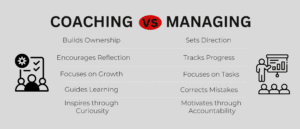Leading Change with Confidence: The Role of Leadership Coaching in Change Management
Change is inevitable. Change is rapid. Change is critical.
According to DDI Global Leadership Forecast managing successful change is one of the most critical skills leaders need to meet key organizational challenges. 63% of leaders surveyed agree it is important, yet only 29% of leaders surveyed have received training.
Organizations, and people, are often resistant to change, even when they know it is necessary. According to Harvard Business Review, there are 7 common reasons why change management strategies fail:
- An incomplete or poorly-defined strategy
- A strategy that is too rigid and inflexible
- Lack of effective communication
- Failing to identify and address resistance
- Disconnect between strategy and culture
- Setting unrealistic expectations
- Not creating and celebrating short term wins
Leadership coaching plays an important role in helping leaders navigate change successfully by providing the support, clarity, and the tools needed to lead themselves and others through uncertainty. A leadership or executive coach will position the strategy by ensuring the vision and change purpose is clear and relevant to long-term goals. A coach acts as a thinking partner to help define and communicate with clarity and confidence.
The Challenges of Change Management
Leadership or executive coaching helps leaders develop self-awareness, empathy, and emotional intelligence. This enables them to manage their own reactions and more effectively support team members who may fear or resist the uncertainty that change brings.
Challenging assumptions and expanding perspective is an ideal mindset to adopt when faced with change, and a coach can support leaders to navigate this. Often the challenge is fighting reactivity instead of initiating proactivity in the organizational culture.
One of the most critical aspects of change leadership is communication. Coaching helps leaders refine their messaging, actively listen, and build trust which is necessary for gaining buy-in, managing conflict, and sustaining momentum. Ultimately the end result is team alignment.
Change can be exhausting and overwhelming. Coaching provides a confidential space for leaders to process challenges, reflect on setbacks, and rediscover their strengths, ultimately building the resilience and confidence needed to persevere.
With so many moving parts in a change initiative, coaching helps leaders stay focused on priorities, take strategic actions, and hold themselves accountable, avoiding distraction or paralysis.
How Leadership Coaching Supports Change
In today’s rapidly changing business landscape, organizations must adapt to new technologies, processes, trends, and market demands. Coaching programs help leaders with the awareness needed to acquire skills and knowledge to embrace change and adapt to new situations. This enables organizations to remain competitive and agile in the face of evolving industry and economic trends.
Besides coping with a changing external or internal landscape, leadership coaching can strengthen leadership adaptability and resilience to enhance decision-making in uncertain times. An important leadership skill is the ability to inspire and engage their teams, and a coach can lend perspective to how a leader might do that given a diverse group of team members.
A coach will also lend perspective to the importance of continuous learning and addressing opportunity areas critical to effective leadership. When a leader is willing to explore professional development, it reflects the organizational culture of doing the same. Whether a CEO or a front-line leader, all levels of leadership will benefit from pursuing professional development.
Case Study: A Leader’s Journey Through Change
The reality is leaders approach change differently. This case study tells a story of a leader whose leadership style is supportive and focuses on relationships. This style naturally prioritizes an energizing, affirming and inclusive culture.
In the face of change, however, the challenges were being expressive enough to provide the necessary inspiration the team needed to embrace change. This leader needed to express how working toward a new vision was going to create positive outcomes for the team, and the team was counting on learning that. Optimism is a key behaviour when leading a team through change that a leadership coach can help with.
This leader’s priority was to maintain harmony, but when issues are not addressed, they fester without going away. Addressing problems in a timely manner creates consistency toward improvement, therefore is not considered discouraging. The leadership coach was able to steer the leader to recognizing, albeit uncomfortable, candid and caring feedback is necessary and will occur when teams are faced with change.
This leader was challenged to see the big picture and instead focused on detail. If one focuses on exploring big picture thinking, and then worries about practical details, the change and new direction is explored and judgement is suspended until buy-on occurs.
To achieve success with the change strategy, this leader learned to focus on a bold, imagined future while dedicating significant effort to aligning the team through clear communication, shared inspiration, consistent momentum, structured execution, and ongoing feedback. https://www.discprofile.com/everything-disc/work-leaders
Conclusion
Leadership coaching is a vital investment (never an expense) when navigating change, which is an inevitable part of leadership. Leaders don’t need to have all the answers or project constant confidence, but they do need to know that a skilled coach can offer an invaluable outside perspective to help build that confidence over time.
In short, leadership and executive coaching equips leaders to be more adaptive, self-aware, and courageous. These are qualities that are essential for guiding teams and organizations through successful change, and beyond.
Because change is inevitable. Change is rapid. Change is critical.
Curious to learn more about Mike Mack and the people behind our work? Meet the team.
Exclusive Insights for Growth—Join Our Newsletter!




